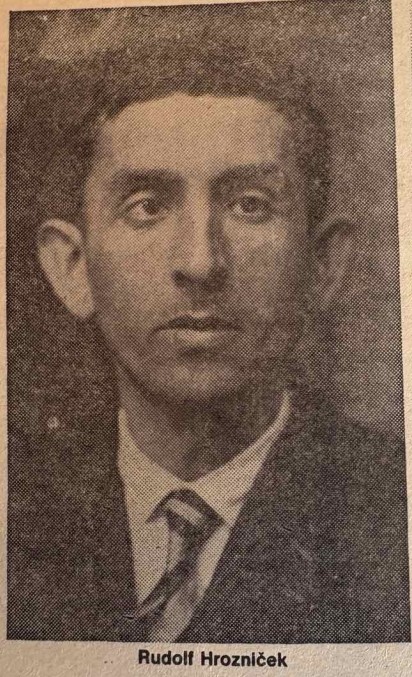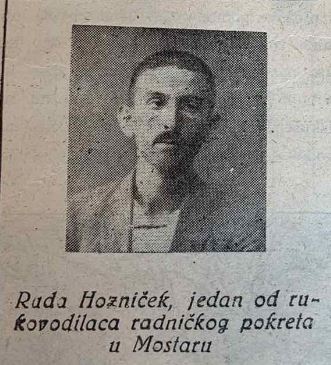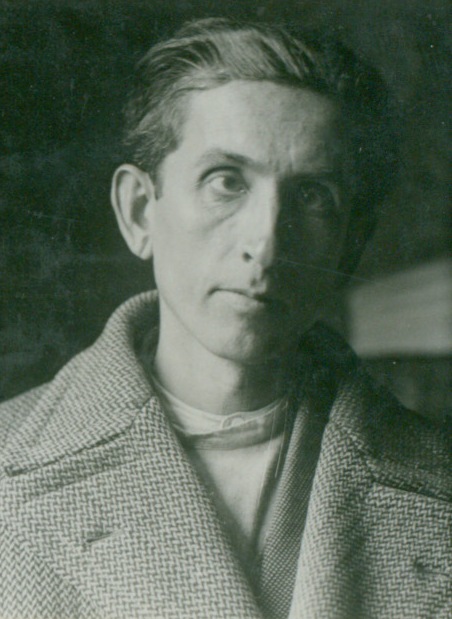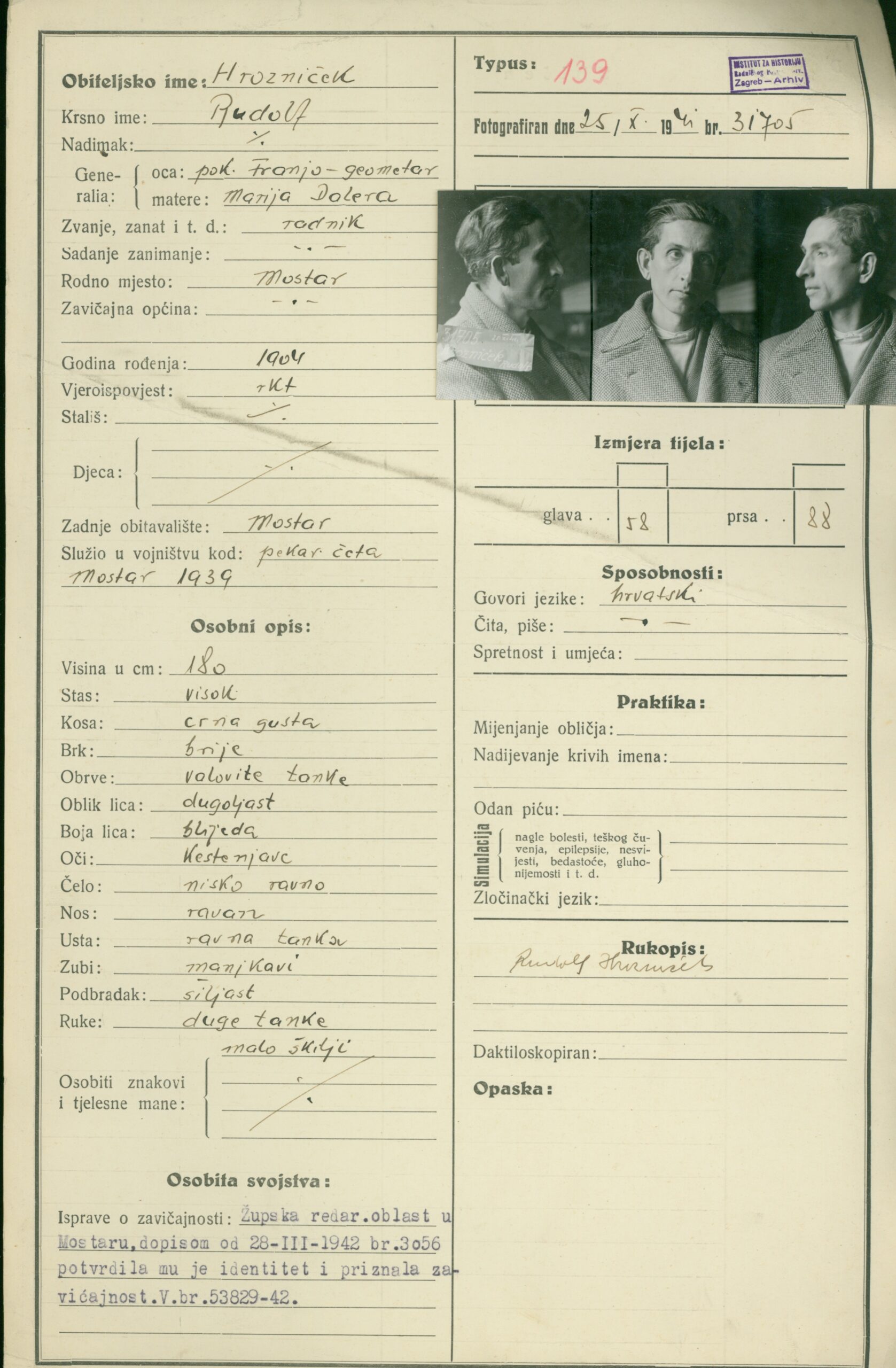
brochure "Partizanski spomenik u Mostaru" (1980)
book “Spomenica Mostara 1941-1945.”
another document or proof of the memorial stone (e.g., a photograph).
Rudolf HROZNIČEK
RUDOLF RUDA HROZNIČEK, son of FRANJO*, born on December 18, 1904, in Kladanj*. He came to Mostar with his family in early childhood. He worked as a lathe operator, metalworker, in Mostar. He was a pre-war communist and revolutionary, arrested and sentenced multiple times. Member of the League of Communist Youth (SKOJ) since 1923 and Communist Party of Yugoslavia (KPJ) since 1927 (according to certain sources, since 1929), member of the District Committee of KPJ for Mostar in 1932, when he participated as a delegate of the party organization of Mostar at the Third Provincial Conference of KPJ for Bosnia and Herzegovina. In late 1932, he was sentenced to two years of imprisonment by the State Protection Court in Belgrade, which he served in Sremska Mitrovica. From 1938, he was a member of the Regional Committee of KPJ for Bosnia and Herzegovina, and from 1940, a member of the Regional Committee of KPJ for Herzegovina. He represented the Mostar communists at the provincial conference of KPJ in the summer of 1938 (Milovan Đilas and Ivo Lola Ribar were also present at the same meeting). He was a functionary of PC “Velež” and a lecturer at the Workers’ Hall. He stood out in the ideological-political and general education of workers.
He was known to the people of Mostar as a “communist who spent a good part of his life in prisons.” Police records from the 1930s stated that he was “irreconcilable, ready for arguments and attacks, a staunch opponent.” On December 24, 1932, he surprised the police chief by admitting during the interrogation that “after leaving prison, he became an even stronger sympathizer of communist work and its ideology.” He was arrested several times in the Kingdom of Yugoslavia, the last time for a strike in the mine after demonstrations organized on the occasion of the anniversary of the German attack on Poland on September 1, 1940, and was sent to the Lepoglava prison.
People in Mostar remembered the forced loading of a group of tied-up communists onto trucks when they were being taken to prison: “Already in their old age, emaciated and unshaven, with a bundle in their bruised hands, he passed through the city with his comrades, singing as if he wanted to uplift and embolden the gathered Skojeces in that final encounter.”
Upon the arrival of the Ustasha regime, he was transferred to several camps: Gospić, Jastrebarsko (August 1941), Danica near Koprivnica, Jasenovac. In early 1942, he ended up in Stara Gradiška. In prisons, the detainees organized themselves as much as possible into the “Collective,” which had its own leadership. The liquidation of old communists began in Stara Gradiška on March 26, 1942, and the first group was sentenced to starvation in the Death Cell. Hrozniček attempted to send a letter from the prison, but the attempt failed, as did the attempt to break out with a group of prisoners. He remained among the nine weakest. He was beaten, his arms and legs were broken, and he was assigned to the second group of the Death Cell on July 5, 1942. He was confined to the same cellar cell, a solitary confinement measuring 2.5 x 3 meters, without windows, where he soon died in the most severe torment, without food and water. (According to “Spomenica Mostara 1941-1945,” he was killed on August 12, 1942.)
He belonged to the pleiad of old Mostar communists, prisoners, whose “moral and communist values were ingrained in the inhabitants of Mostar, especially in the youth.” Before entering the Death Cell, according to one source, he said to his comrades, “They have broken my legs and arms, but they cannot break the Party. They cannot tear out my soul!”
He was described as “quiet, but with the same desire for education and with a solid and broad knowledge and culture… inclined towards teaching and educating others. He exuded a certain moral strength that captivated people and simply compelled them to confide in him and complain about injustice. As an unwavering communist, he acted from Marxist positions, very skillfully, explaining to his interlocutors everything they asked him. He spoke softly, but so eloquently and richly that he captivated people.”
(* According to the data from the book “Spomenica Mostara 1941-1945.”)
Ćemalović, Enver (1986): Mostarski bataljon, Mostar; JUSP Jasenovac – Predstavljanje knjige „Ćelija smrti“ autora Đorđa Mihovilovića u Sveučilišnoj knjižnici u Splitu (jusp-jasenovac.hr); http://rsdvelezmostar.blogspot.com/p/fk-velez.html; https://www.portalnovosti.com/mostarke-otpor-u-zicama; grupa autora (1986): Hercegovina u NOB 4. dio, Beograd; Konjhodžić, Mahmud (1981): “Mostarke”: fragmenti o revolucionarnoj djelatnosti i patriotskoj opredjeljenosti žena Mostara, o njihovoj borbi za slobodu i socijalizam, Opštinski odbor SUBNOR-a Mostar; grupa autora (1961): Hercegovina u NOB 1. dio, Beograd, Vojno delo; grupa autora (1986): Hercegovina u NOB 2. dio, Beograd; група аутора (1986): Херцеговина у НОБ, Београд ; https://www.portalnovosti.com/mostarke-otpor-u-zicama; Seferović, Mensur: Mostarski kolopleti, edicija “Mostar u borbi za slobodu”, knjiga 8, Mostar; grupa autora: Spomenica Mostara 1941-1945.; Ljubo Gordić, Refik Hamzić „Partizanski doktor Safet Mujić“; https://www.researchgate.net/publication/365127532_Pregled_ceskih_cinovnika_u_upravi_tuzlanskog_okruga_1884-1914_Prilog_proucavanju_ucesca_Ceha_u_upravi_Bosne_i_Hercegovine Fotografija: JUSP Jasenovac, Mihovilović, Đorđe: Ćelija smrti; Članak u Pravdi 12.6.1933.; policijski karton Rudolfa Hrozničeka, HDA – fond 259 ROZ (redarstvena oblast Zagreb), policijski karton broj 1803.
Photo of the memorial plaque: S. Demirović
Do you have more information about this fighter? Share your stories and photographs. Let's keep the memory alive!







